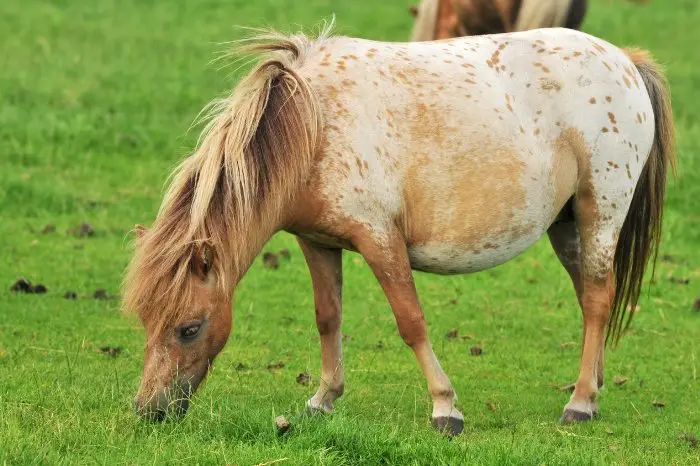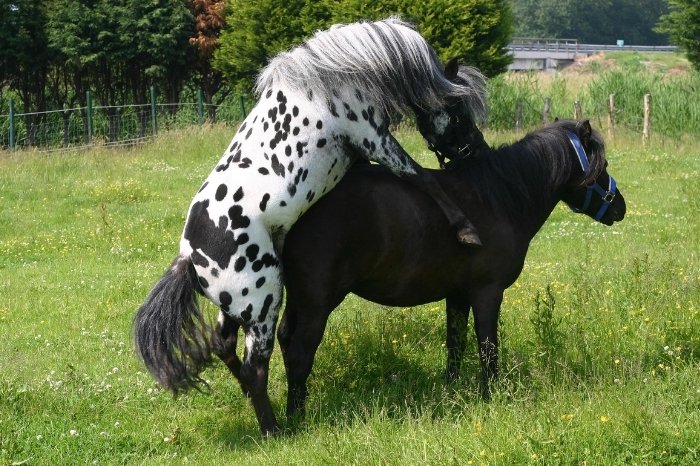Last Updated on November 6, 2021
If you’ve never seen miniature horses mating, you might be wondering how it all happens! A horse conception, pregnancy, and birth is a difficult process and a true miracle of nature. But does it all work the same when it comes to miniature horses mating?
If you’re planning on putting your miniature horse in foal, or are just interested in what happens, there is a lot to learn about mini horse breeding. When it comes to miniature horses, reproduction isn’t always easy, and many things can go wrong! Let’s take a look at all you need to know about mini horse breeders and how it all works.
Miniature Horses Mating – The Reproductive Process
Miniature horse reproduction is the process by which a mare, or female horse, becomes pregnant and gives birth to a foal. In order to become pregnant, the mare must be mated with an entire male horse. This is called conception and results in an embryo forming within the mare’s reproductive organs.
The pregnancy lasts for around 11 months, and during the period, the embryo develops into a full-size foal. At the end of her pregnancy, the mare will give birth.

The birth is also called parturition, labor, or foaling. This takes place over several stages. Foaling is a high-risk time for both the mare and the foal.
Mini Horses Mating – The Conception
For successful mini horse breeding, we need to start with the conception. Without this, the mare will not become pregnant!
All female equines have a 21-day long fertility cycle. The mare is fertile for about 5 days during this period – this is the time that she is able to become pregnant. If miniature horse mating does not happen in these 5 days, then she will not become pregnant.
For a successful conception, an entire male horse – also called a stallion – is needed to impregnate the female horse. Conception can happen in one of two ways.
The first way a mini horse mating can happen is by a process called natural covering. The entire male horse mates with the female horse, in the same way as they would in the wild.

This can be a controlled process, where the breeder chooses when to allow them to mate. Alternatively, the mare and stallion may be permitted to mate whenever they choose if they are allowed to graze together in the same field.
The other miniature horse mating method is called artificial insemination. This process involves collecting semen from the stallion, by allowing him to mate with a ‘dummy’ mare. This semen is then used to inseminate the mare at the exact time that she is most likely to become pregnant.
Artificial insemination is a very popular way to create a horse pregnancy. It is less risky for the mare and stallion. It also enables mares and stallions who live a long distance apart to be bred together.
Miniature Horse Breeding Facts
So, this is the process for horse breeding, but are things any different for mini horses?
The small size of miniature horses can create a few problems when it comes to breeding. Firstly, their tiny body size can make it difficult for your veterinarian to carry out a lot of the normal tests and examinations which are recommended during equine pregnancy. It may be that the mare is also too small for artificial insemination to take place!
When breeding miniature horses, only the best breeding stock must be used. These equines have been intensively bred to create a miniature horse with desirable characteristics, but any genetic abnormalities will quickly become exaggerated. If your miniature horse mare is not perfect in confirmation and character, it would not be advisable to breed from her.
Horses Mating Ponies – Is It Any Different?
When mating horses of different sizes, some physical problems can occur. If the stallion is much smaller than the mare, he may not be able to mount her and successfully impregnate her. This problem can be overcome by using a raised ramp for the stallion.
On the other hand, a large stallion may injure a smaller mare if he attempts to mate with her. Under these circumstances, it is best if a controlled mating takes place, with human handlers to keep both mare and stallion safe. Both of these issues can also be solved by carrying out artificial insemination.
When it comes to pregnancy, breeding mares and stallions of different sizes should not cause any issues. During pregnancy, the mare will ensure that the foal only grows to a size that she can give birth to. Once born, the foal will grow to the size it is genetically programmed to reach.
Where To Find Mini Horse Breeders
If you are new to the world of horse breeding, it is vital to seek expert advice. A good mini horse breeder will help you to choose the right stallion for your mare and assist you with the process of conception from start to finish.
To find a good miniature horse stud farm, start by speaking to your breed society. They may hold a list of recognized breeders, or be able to recommend an expert in your local area.
It is also a good idea to approach other local miniature horse owners, as they will know of mini horse breeders in your region. Other local experts include your veterinarian, local equine feed supplier, farrier, or equine dentist.
Once you have found a mini horse breeder you are happy with, ask to see examples of their young stock from the stallion you have chosen. You should also ask an expert to assess your mare to ensure she is suitable for breeding.
Summary
So, today we have learned some amazing facts about miniature horses mating! We hope our guide to mini horse reproduction will be helpful to you, and that you have enjoyed our interesting facts about horse reproduction.
Do you have any questions about miniature horses mating? Or maybe you’ve been lucky enough to see real-life miniature horse foaling? Add a comment below this post and we’ll get back to you!

Kate Chalmers is a qualified veterinary nurse who has specialized in horse care for the vast majority of her career. She has been around horses since she was a child, starting out riding ponies and helping out at the local stables before going on to college to study Horse Care & Management. She has backed and trained many horses during her lifetime and competed in various equestrian sports at different levels.
After Kate qualified as a veterinary nurse, she provided nursing care to the patients of a large equine veterinary hospital for many years. She then went on to teach horse care and veterinary nursing at one of the top colleges in the country. This has led to an in-depth knowledge of the care needs of horses and their various medical ailments, as well as a life-long passion for educating horse owners on how to provide the best possible care for their four-legged friends.
Kate Chalmers BSc (Hons) CVN, Dip AVN (Equine) Dip HE CVN EVN VN A1 PGCE

